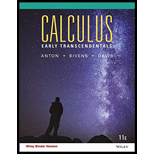
Use the Divergence Theorem to find the flux of F across the surface
Want to see the full answer?
Check out a sample textbook solution
Chapter 15 Solutions
CALCULUS EARLY TRANSCENDENTALS W/ WILE
Additional Math Textbook Solutions
Calculus: Single And Multivariable
Calculus 2012 Student Edition (by Finney/Demana/Waits/Kennedy)
Precalculus: Mathematics for Calculus - 6th Edition
Precalculus: Concepts Through Functions, A Unit Circle Approach to Trigonometry (4th Edition)
Calculus: Early Transcendentals (2nd Edition)
- Evaluate F.ndS for the given F and ơ. (b) F(x, y, z) = (x² + y) i+ xyj – (2xz + y) k, o : the surface of the plane x + y + z = 1 in the first octantarrow_forwardLet the surface xz – yz³ + yz? = 2, then - the equation of the tangent plane to the surface at the point (2, –1, 1) is: O x – y + 3z = 5 O x - 3z = 5 O x + 3z = 5 O x + y+ 3z = 5 O y+ 3z = 5arrow_forwardFind a parametrization of the curve of intersection of the surfaces z = x² – y² and z = x2 + xy + 1.arrow_forward
- Use the Divergence Theorem to find the flux of F(x, y, z)=z³ i-x³j+y³ k across the sphere x² + y² + z² = a² with outward orientation. $ = iarrow_forwardfind the outward flux of F across the boundary of D. F =-2x i - 3y j + z k D: The upper region cut from the solid sphere x2 + y2 + z2 <=2 by the paraboloid z = x2 + y2arrow_forwardFind the flow of F=xzi-yk through the upper part of plane z-1 in the x + y +2 = 4sphere.arrow_forward
- Let S be the portion of the plane 2x + 3y + z = 2 lying between the points (−1, 1, 1), (2, 1, −5), (2, 3, −11), and (-1, 3, -5). Find parameterizations for both the surface S and its boundary S. Be sure that their respective orientations are compatible with Stokes' theorem. from (-1, 1, 1) to (2, 1,-5) from (2, 1, 5) to (2, 3, -11) from (2, 3, -11) to (-1, 3, -5) from (-1, 3, 5) to (-1, 1, 1) boundary S₁ (t) = S₂(t) = S3(t) = S4(t) = Φ(u, v) = te [0, 1) te [1, 2) te [2, 3) te [3, 4) UE [-1, 2], VE [1, 3]arrow_forwardCalculate SLĒ F.dS where F = (4x³z, 4y³z, 3z4) and S is the surface of the solid bounded by the - hemispheres z = √√/16 – x² – y², z = √√√9 — x² - y² and - the plane z = 0.arrow_forwardLet F(x, y, z)=(v)i+(x)j+(z²)k. Find the flux of F across the positively oriented closed surface S where S is the surface of the sphere x + y +z² = 4.arrow_forward
- The points on the surface x2−2y2−3z2 = 33 at which the tangent plane is parallel to the 8x+4y+6z=5 plane are:a. (1,0,1) y (2,3,1)b. (-4√3, √3, -√3) and (-4√3, -√3, √3) c. (4√3, -√3, -√3) and (-4√3, √3, √3) d. (-4√3, -√3, -√3) and (-4√3, -√3, √3)arrow_forwardFind a parametrization of the surface z = 3x² + 8xy and use it to find the tangent plane at x = 1, y = 0, z = 3. (Use symbolic notation and fractions where needed.) z =arrow_forwardEvaluate the circulation of G = xyi + zj + 4yk around a square of side 4, centered at the origin, lying in the yz-plane, and oriented counterclockwise when viewed from the positive x-axis. Circulation = Jo F. dr =arrow_forward
 Calculus: Early TranscendentalsCalculusISBN:9781285741550Author:James StewartPublisher:Cengage Learning
Calculus: Early TranscendentalsCalculusISBN:9781285741550Author:James StewartPublisher:Cengage Learning Thomas' Calculus (14th Edition)CalculusISBN:9780134438986Author:Joel R. Hass, Christopher E. Heil, Maurice D. WeirPublisher:PEARSON
Thomas' Calculus (14th Edition)CalculusISBN:9780134438986Author:Joel R. Hass, Christopher E. Heil, Maurice D. WeirPublisher:PEARSON Calculus: Early Transcendentals (3rd Edition)CalculusISBN:9780134763644Author:William L. Briggs, Lyle Cochran, Bernard Gillett, Eric SchulzPublisher:PEARSON
Calculus: Early Transcendentals (3rd Edition)CalculusISBN:9780134763644Author:William L. Briggs, Lyle Cochran, Bernard Gillett, Eric SchulzPublisher:PEARSON Calculus: Early TranscendentalsCalculusISBN:9781319050740Author:Jon Rogawski, Colin Adams, Robert FranzosaPublisher:W. H. Freeman
Calculus: Early TranscendentalsCalculusISBN:9781319050740Author:Jon Rogawski, Colin Adams, Robert FranzosaPublisher:W. H. Freeman
 Calculus: Early Transcendental FunctionsCalculusISBN:9781337552516Author:Ron Larson, Bruce H. EdwardsPublisher:Cengage Learning
Calculus: Early Transcendental FunctionsCalculusISBN:9781337552516Author:Ron Larson, Bruce H. EdwardsPublisher:Cengage Learning





